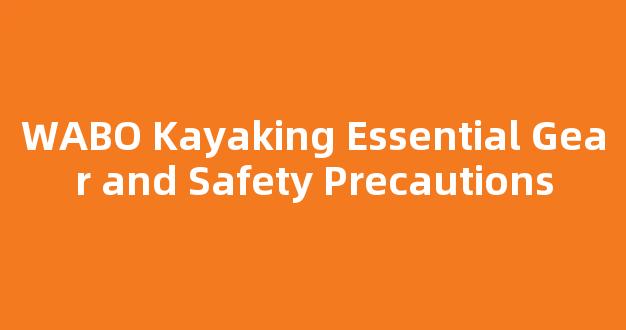WABO Kayaking: Essential Gear and Safety Precautions
Kayaking is an exhilarating outdoor activity that allows you to explore beautiful waterways and experience nature in a unique way. Whether you’re a beginner or an experienced kayaker, having the right gear and following safety precautions is crucial for an enjoyable and safe adventure. In this article, we’ll discuss the essential gear needed for kayaking and important safety measures to keep in mind.
The Essential Gear
Kayak: The most important piece of gear is, of course, the kayak itself. There are various types of kayaks designed for different activities, such as touring, whitewater paddling, and fishing. It’s essential to choose a kayak that suits your intended use and skill level.
Paddle: A high-quality paddle is key to maneuvering your kayak efficiently. Consider factors such as material, blade shape, and shaft length when selecting a paddle that’s comfortable for you.
Personal Flotation Device (PFD): A PFD is a must-have for all kayakers, regardless of their swimming abilities. Ensure that your PFD fits properly and is approved by relevant safety standards.
Spray Skirt: If you’re kayaking in rough waters, a spray skirt can help keep water out of the cockpit, keeping you dry and improving your stability.
Helmet: For whitewater kayaking, wearing a helmet is essential to protect your head from potential impacts with rocks and other obstacles.
Dry Bag: Keep your belongings safe and dry by storing them in a waterproof dry bag. This is especially important if you plan on bringing electronics or valuables on your kayaking trip.
Navigation Tools: Depending on your trip, you may need a map, compass, or GPS device to help you navigate unfamiliar waters.

Safety Precautions
Weather Awareness: Check weather forecasts before heading out and be aware of changing conditions while on the water. Avoid kayaking in strong winds, thunderstorms, or foggy conditions.
Skill Development: It’s important to develop your paddling skills and knowledge of water safety. Consider taking lessons or joining a guided tour to improve your abilities and learn from experienced instructors.
Buddy System: Whenever possible, kayak with a companion or in a group. In case of an emergency, having others nearby can provide assistance and support.
First Aid Kit: Carry a basic first aid kit and know how to use it. Injuries can occur while kayaking, so being prepared to address minor wounds or injuries is essential.
Respect Wildlife: When kayaking in natural habitats, maintain a respectful distance from wildlife and avoid disturbing their natural behaviors. Take photos from a distance and refrain from feeding or approaching animals.
Conclusion
By ensuring you have the essential gear and following important safety precautions, you can enjoy kayaking while minimizing risks and staying safe on the water. Remember to always prioritize safety, stay informed about local regulations, and continue to expand your skills and knowledge as a kayaker. With the right preparation and mindset, kayaking can be an incredibly rewarding and memorable experience.